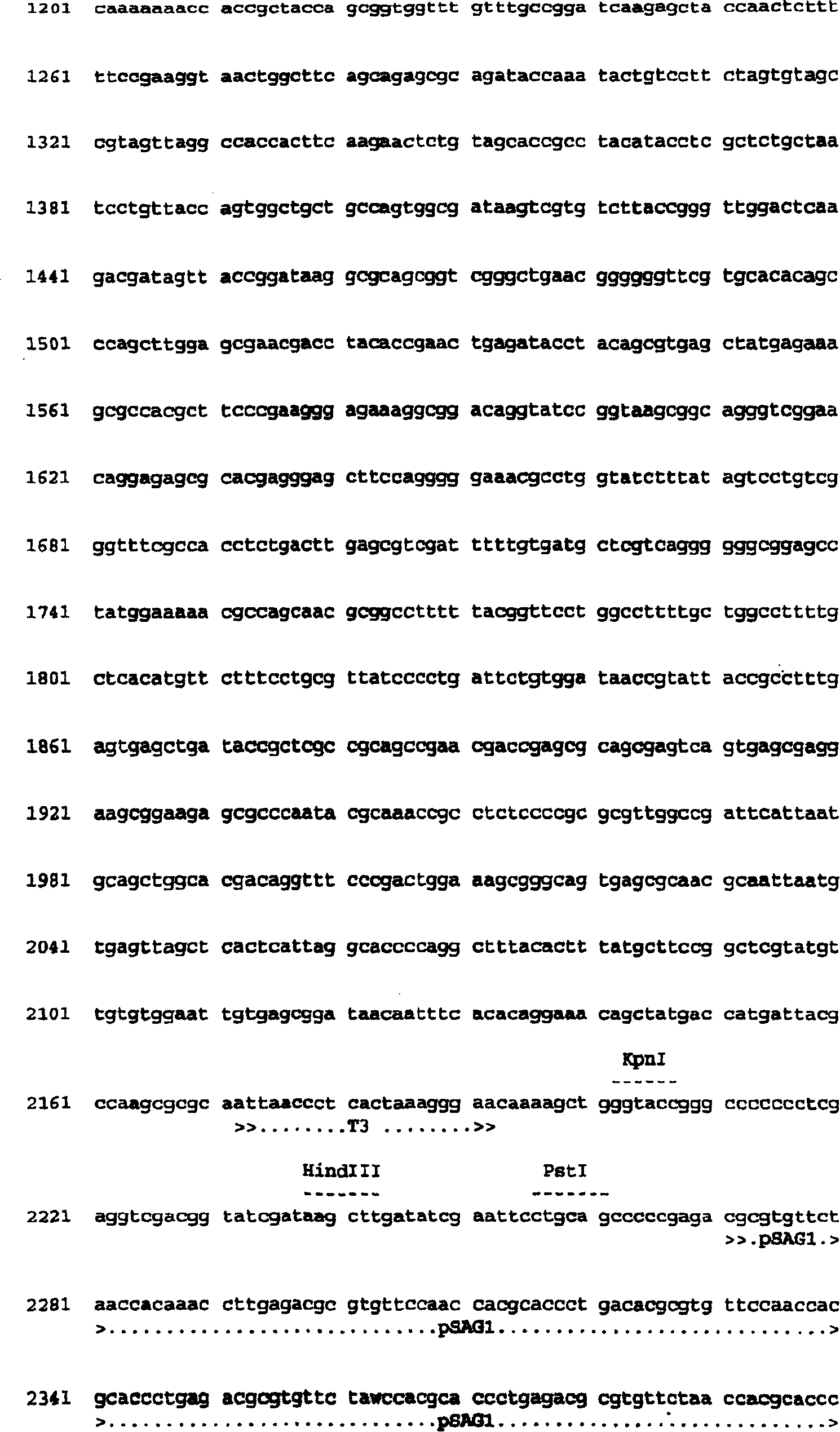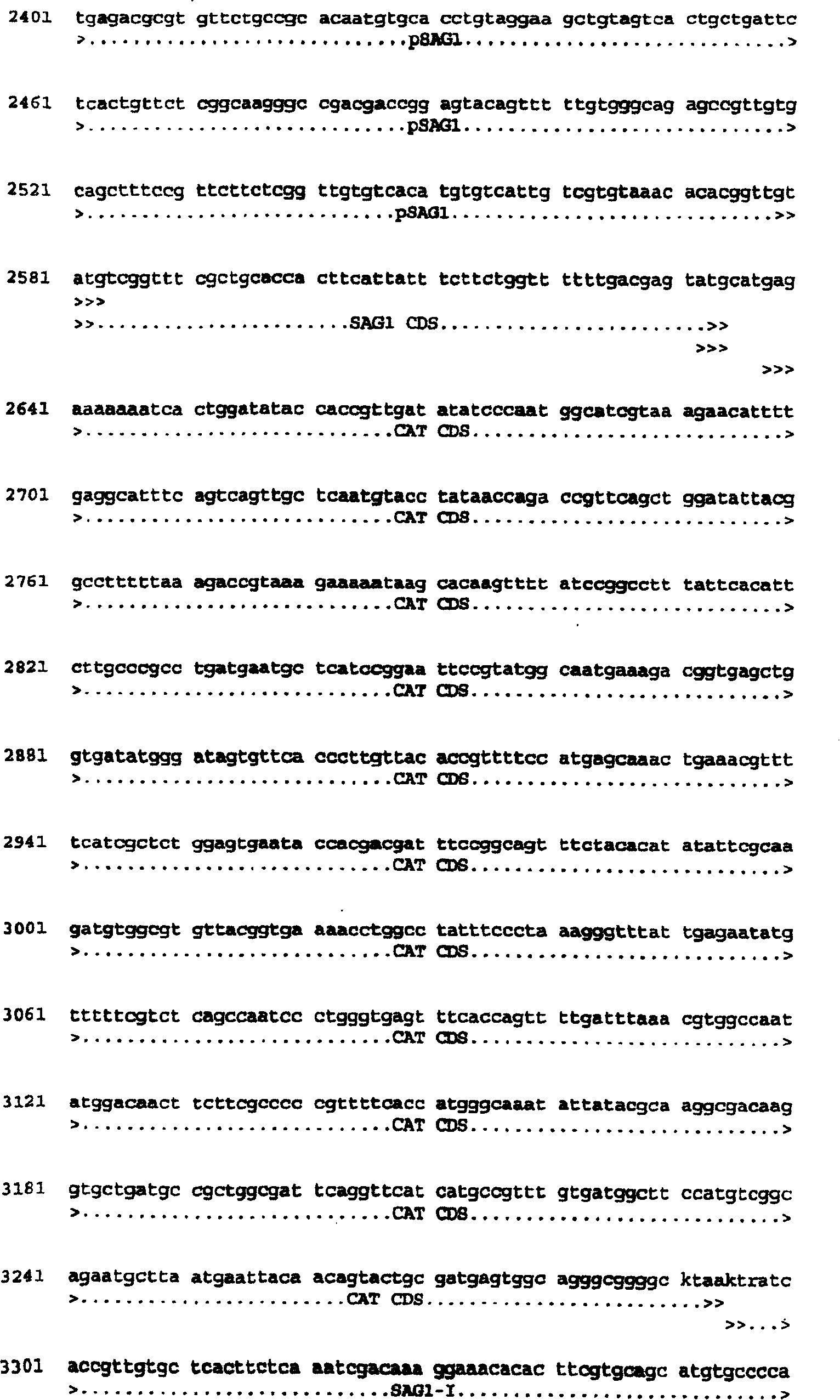Live antenuated parasite vaccine
A technology for parasites and vaccines, applied in protozoa, protozoan antigen components, biochemical equipment and methods, etc., can solve the problems of time-consuming, complicated vaccine development, and not providing local immunity
- Summary
- Abstract
- Description
- Claims
- Application Information
AI Technical Summary
Problems solved by technology
Method used
Image
Examples
Embodiment 1
[0154] Primers used during the experimental procedure:
[0155] Inserted restriction sites are underlined.
[0156]
[0157] Construction of TubYFP / TR-sagCAT (9332bp)
[0158] The plasmid ptubYFP / TR-sagCAT was stepwise engineered as described below. First, using primers SAG3FW (#1, SEQ ID NO: 5) and TUB5RV (#2, SEQ ID NO: 6), by constructing from ptubYFP / YFP-sagCAT (Llopis, J. et al., PNAS 97 (8): 4363-4368 (2000)) amplified the murine Toxoplasma gondii tubulin A (tub) promoter to make construct ptubCAT / GFP. The PCR product and plasmid pdhfrCAT / GFP were digested with HindIII and BgIII (Striepen, B. et al., Molecular and Biochemical Parasitology 92:325-338 (1998)). and connect them to each other. This generated ptubCAT / GFP in which the dhfr promoter had been replaced with the tub promoter. The resulting plasmid is based on Bluescript pKS+ (Stratagene, La Jolla, CA), and contains the α-tubulin promoter to which the fusion of the chloramphenicol acetyltransferase (CAT) ...
Embodiment 2
[0163] Determination of the Initiation Transcription Site of S13 Ribosomal Protein Gene of Toxoplasma gondii
[0164] To determine the initiation of transcription of the ribosomal protein gene S13, RNA was isolated from murine Toxoplasma gondii RHΔHXGPRT tachyzoites grown in Vero cells. Using GeneRacer Kit (Invitrogen) to obtain gene-specific full-length cDNA from total RNA. Using this kit, oligo RNA is ligated to the end of full-length mRNA, and after reverse transcription with oligo dT, the product is amplified by PCR using GeneRacer primers combined with oligo RNA and gene-specific primers. The start of transcription (STS) can then be determined. For ribosomal protein gene S13, this can be done using the following primers: REV13A (#7, SEQ ID NO: 11) and REV13B (#8, SEQ ID NO: 12). Primer #7 was used with the GeneRacer primer to obtain the product, followed by primer #8 for nested PCR. The PCR product showed 3 bands; 2 weak and 1 strong. The band showing the greatest a...
Embodiment 3
[0166] S13 / LZ construct
[0167] To test the induced expression of the tet repressor, several reporter constructs were made using the lacZ gene under the control of the S13 promoter with and without the presence of a single tetO site. First, plasmid S13 / lacZ was prepared (see Figure 2 for structure and sequence of the final construct), which was then used to insert or replace the tetO site sequence as described below.
[0168]The S13 primer was amplified by PCR from genomic DNA of the murine Toxoplasma gondii RH / ΔHXGPRT strain using primers S13PROMFUS FW (#9, SEQ ID NO: 13) and S13PROMFUS RV (#10, SEQ ID NO: 14) sub-area. The lacZ coding sequence was amplified by PCR from genomic DNA of BL21 bacteria using primers LACZ-AVRII FW (#11, SEQ ID NO: 15) and LACZ-PSTI RV (#12, SEQ ID NO: 16). Subsequently, the S13 PCR product was digested with HindIII and XbaI, while the lacZ PCR product was digested with AvrII and PstI. The plasmid ptubYFP / YFP-sagCAT was used to exchange the ptu...
PUM
 Login to View More
Login to View More Abstract
Description
Claims
Application Information
 Login to View More
Login to View More - R&D
- Intellectual Property
- Life Sciences
- Materials
- Tech Scout
- Unparalleled Data Quality
- Higher Quality Content
- 60% Fewer Hallucinations
Browse by: Latest US Patents, China's latest patents, Technical Efficacy Thesaurus, Application Domain, Technology Topic, Popular Technical Reports.
© 2025 PatSnap. All rights reserved.Legal|Privacy policy|Modern Slavery Act Transparency Statement|Sitemap|About US| Contact US: help@patsnap.com



